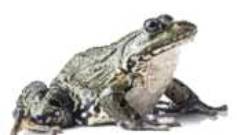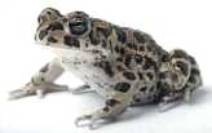Controverscial.Com
![]()
Welcome
![]()
|
Controverscial.Com
Welcome
|
|
|
Controverscial.Com
Welcome
|





Commonly found on all continents except Antarctica, frogs and toads throughout the ages have attracted awe and revulsion from many cults and cultures. Many differing and contradictory beliefs have survived to the present day, and past associations with witchcraft, medicine, weather, birth, death and rebirth continue to stimulate many superstitions and fears.
Frogs and Toads are amphibian creatures of the order ‘Anura’, meaning ‘without a tail’. There are some 24 different families of frogs and toads with more than 3,800 species. Frogs usually have squat bodies with smooth moist skin, bulging eyes that allow them to see in all directions, no tail, webbed feet for swimming and strong hind legs for jumping. There are no clear distinctions between frogs and toads, except that toads generally have dry warty skin and short hind legs more suitable for walking than for jumping. Both are commonly found in warm moist tropical regions, but they can also be found in mountains and deserts.
Most frogs are aquatic and will often sit in water with just their eyes and nose above the surface. The eyelids of a frog cannot move and to close its eyes, they must draw them back into their sockets. They also do this while swallowing food, since the in-drawn eyes add pressure to the roof of the mouth helping to move food down into the throat. Frogs have teeth in the upper jaw, but these are quite feeble and used only to grip it’s prey rather than for chewing. The prey can be anything that fits into the frog's mouth such as: insects, spiders, snails, worms and small fish; bigger frogs may even eat mammals such as: mice, small birds and other frogs. Many frogs have a long sticky tongue, which they use to capture their prey.
Not all frogs have a long tongue; those that don't, use their fingers to feed prey into their mouths. Frogs have 4 fingers on their front feet, and 5 toes on the back. A frog's long hind legs allows them to jump great distances, often more than 20 times their body length. To survive a frog must keep its skin moist, which is why they can usually be found close to water, and why they like to hide in moist places while on land. They also have glands that secrete mucus helping to keep their skin moist. While frogs have lungs, they also take in oxygen through the skin, which aids respiration when underwater. Most frogs regularly shed the upper layer of their skin (the epidermis), and the old skin is usually eaten.
Frogs start mating when the males of a species move to breeding ponds and begin croaking their mating calls to attract females. They do this using a vocal sac, which produces sounds unique to their own kind that the females can identify with. When they meet, the male climbs on the back of the female and puts his arms around her in a strong grip, a position called “amplexus”. When the female lays her eggs, the male releases his sperm to fertilize them. The number of eggs laid can number from a few hundred to thousands. The time it takes the eggs to hatch varies between species, but usually takes between 6 and 21 days.
From the egg emerges a tadpole, a fish-like creature with a round body, a tail and gills. Tadpoles do little more than eat, feeding mostly on algae when still young, and later on plants, insects and dead animals. After about 6-9 weeks, the tail starts to disappear and is replaced with arms and legs. The hind legs appear first, then the arms. The tadpole then develops lungs and just before it becomes a real frog, the gills disappear. The whole process usually takes between 12-16 weeks, and when complete, the newly formed frog leaves the water. The life span of a frog depends on the species and can range anywhere between 2 and 40 years, but the average is more likely between 4 and 15 years.
The toad more than the frog is most commonly associated with poison. When a toad is molested it secrets or ejects poison that irritates the eyes and mucous membranes of many, but not all of its predators. The poisons of the Colorado River toad (B. alvarius) and the Giant toad (B. marinus, also called the cane toad) affect animals as large as dogs, and in some instances can cause temporary paralysis or even death. Dried toad poison has been used to treat various ailments in the past, and it is known that some species of toad poison can produce hallucinogenic effects in humans.
Contrary to popular belief, toads do not cause warts.
For thousands of years, frogs and toads have been associated with myths, folklore and magic. Sadly many of these myths and tales portray them as demons, creatures associated with the devil. Some cultures however viewed them in a positive light, and saw them as representative of good fortune, protection, rain and fertility. In some cultures the frog symbolized resurrection and a higher stage of spiritual awakening. In the Rig Veda creation myths of the Hindus, the Great Frog supports the universe and is representative of the matter from which all is created.
In ancient times clay used to make pottery was collected from the banks of natural rivers and lakes, sites that would have had an abundance of frogs and toads. The peoples of ancient Mesopotamia for example, collected clay from along the Tigris and Euphrates Rivers, where they undoubtedly encountered frogs and toads and later adopted them into their religious beliefs.
The Egyptians believed frogs to have been formed from mud and water, a belief that seems to have materialized as a result of rivers flooding during the rainy season, at which time frogs reproduced in such quantities that thousands of tiny frogs and toads invaded walkways and public areas; they even entered private homes and in general were regarded as pests. This phenomenon was dubbed “Frog Rain”, because such occurrences always happened after the first heavy rains of the season. As such frogs became associated with weather predictions because they would begin croaking just before rains.
In Egypt the frog was most commonly associated with the goddess Heket (or Heqet), the goddess of fertility and childbirth who assisted Isis in her ritual to resurrect Osiris. Heket is depicted as a frog-shaped goddess, whose priestesses trained as midwives. They wore amulets, jewellery and other ornaments that bore her image. Frog shaped knives placed on to the bellies of pregnant women and newborn babies were believed to protect their youngsters. Frogs in general were so important to the early Egyptians they were often embalmed after death.
In ancient China the toad was a trickster and a magician, a master of escapes and spells. But he was also the keeper of powerful secrets. One legend tells a story of a wandering wise old man called Liu Hai and his three-legged toad companion Ch'an Chu. Ch'an Chu knew the secret of eternal life, and due to his masters kindness he revealed the secret to the wise man. In Japan a similar legend involves the Gama-Sennin, also known as Kosensei, a wise old man with a hunched body and a warty face. Kosensei wanders the land with his toad companion, who teaches him the secret powers of herbs, including the secret of immortality.
Frogs and toads go through at least one major transformation during their lives, that from tadpole to adult. Many also shed their skins regularly as they grow, and some even eat their discarded skin. These transformations may explain why many cultures saw frogs and toads as symbolic of re-creation, or as keepers of the secrets of life after death. Members of the Olmec tribes of early Mesoamerica created images of a toad as the ‘God of rebirth’, reborn after consuming itself and thus caught up in the never-ending cycle of life and death.
As much as the frog was seen as a symbol of life and birth, it was also seen as a symbol of death. Some European myths tell that it was bad luck to kill a frog for they housed the souls of dead children. In the ancient Zoroastrian religion of the Middle East the frog was associated with Ahriman (the most evil of all beings). In Europe, it wasn’t until the Middle Ages that the frog was given such an unfavourable reputation, and the frog went from being a sacred symbol of creation to a manifestation of evil. The frog (along with other animals) was quickly associated with Witches, and thought to be their devoted magical animal used to carry out all sorts of diabolical deeds.
In early Christianity, demonologists often referred to frogs as the ‘Witches Familiar’ or ‘Agent of the Devil’. The fact that frogs resided in swamps and stagnant pools, often dirty and unsanitary places, was used to exemplify the power of consecrated holy water to expel evil spirits and purify sinners. Witches were thought to use frogs and toads in satanic rituals, and to concocted malicious sounding spells and potions from their body parts. Some believe that a witch could be identified by a mark shaped like a toad’s foot secreted on her body or that the image of a toad would be visible in the left eye. Other myths tell of witches extracting toad secretions, or collecting toad saliva for use in flying potions and invisibility spells.
In the Witch trials at St. Osyth in England, Ursula Kempe's young son testified that one of her four familiars, a black toad named Pigin, had once caused illness in a young boy. Toads were also popular as poisonous ingredients in potions: “the women-witches of ancient time which killed by poysoning, did much use toads in their confections”. Witches were also believed to control the weather by concocting brews from frogs, toads and snakes, often referred to as “Toad Soup”. Undoubtedly, many experienced illness or death after ingesting or applying some sort of frog-made brew including their toxic secretions. Such folklore and popular mythology was the result of Inquisitional propaganda to eliminate the old Pagan religions and prosecute Witches with charges of heresy during the persecution years.
Frogs and toads since ancient times have been highly regarded for possessing medicinal properties. Pieces taken from a frog’s body were used as aphrodisiacs to aid impotence and boost fertility. A frog’s liver was believed to be an antidote to all poisons, while a toad’s lungs provided the means to the “perfect murder of a wayward husband”. In many Shaman traditions of the Americas, hallucinogenic compounds derived from toads are used in religious rituals for communion with the spirit world and for self-transcendence. In many cases, these myths have some foundation in truth, as some species contain compounds both poisonous and hallucinogenic.
One of the most widely told myths concerning the toad is that of the “Toad-Stone”, a fabulously jewelled stone that grows inside the toad’s head. This jewelled stone when placed in a ring or a necklace, would heat up or change colour in the presence of poison, thereby protecting the wearer from the dangers of poisoning, a common threat in the Middle Ages.
To be added.
![]()
![]()

Let there be peace in the world - Where have all the flowers gone?
My Personal Page / My Place in England, UK / My Family Tree (Ancestry)
Wicca/Witchcraft / What is Wicca / What is Magick
Traditional Writings:
Wiccan Rede / Charge of the Goddess / Charge of the God / The Three-Fold Law (includes The Law of Power and The Four Powers of the Magus) / The Witches Chant / The Witches Creed / Descent of the Goddess / Drawing Down the Moon / The Great Rite Invocation / Invocation of the Horned God / The 13 Principles of Wiccan Belief / The Witches Rede of Chivalry / A Pledge to Pagan Spirituality
Correspondence Tables:
Incense / Candles / Colours / Magickal Days / Stones and Gems / Elements and Elementals
Traditions Part 1 - Alexandrian Wicca / Aquarian Tabernacle Church (ATC) / Ár Ndraíocht Féin (ADF) / Blue Star Wicca / British Traditional (Druidic Witchcraft) / Celtic Wicca / Ceremonial Magic / Chaos Magic / Church and School of Wicca / Circle Sanctuary / Covenant of the Goddess (COG) / Covenant of Unitarian Universalist Pagans (CUUPS) / Cyber Wicca / Dianic Wicca / Eclectic Wicca / Feri Wicca /
Traditions Part 2 - Gardnerian Wicca / Georgian Tradition / Henge of Keltria / Hereditary Witchcraft / Hermetic Order of the Golden Dawn (H.O.G.D.) / Kitchen Witch (Hedge Witch) / Minoan Brotherhood and Minoan Sisterhood Tradition / Nordic Paganism / Pagan Federation / Pectic-Wita / Seax-Wica / Shamanism / Solitary / Strega / Sylvan Tradition / Vodoun or Voodoo / Witches League of Public Awareness (WLPA) /
Gods and Goddesses (Greek
Mythology) / Esbats &
Full Moons / Links
to Personal Friends & Resources / Wicca/Witchcraft
Resources / What's a spell? /
Circle Casting and
Sacred Space / Pentagram
- Pentacle / Marks
of a Witch / The Witches
Power / The Witches Hat
/ An
esoteric guide to visiting London / Satanism
/ Pow-wow
/ The
Unitarian Universalist Association / Numerology: Part 1
/ Part 2 / Part
3 / A
history of the Malleus Maleficarum: includes: Pope
Innocent VIII /
The
papal Bull /
The
Malleus Maleficarum /
An extract from the Malleus Maleficarum
/ The letter of approbation
/ Johann
Nider’s Formicarius /
Jacob
Sprenger /
Heinrich Kramer /
Stefano Infessura
/ Montague Summers /
The Waldenses
/ The Albigenses
/
The Hussites / The
Sun Dance
/ Shielding (Occult
and Psychic Protection) /
Sabbats in History and Mythology / Samhain (October 31st) / Yule (December 21st) / Imbolc (February 2nd) / Ostara (March 21st) / Beltane (April 30th) / Litha (June 21st) / Lughnasadh (August 1st) / Mabon (September 21st)
Rituals contributed by Crone: Samhain / Yule / Imbolc / Ostara / Beltane / Litha / Lammas / Mabon
Tools of a Witch / The Besom (Broom) / Poppets and Dolls / Pendulums / Cauldron Magick / Mirror Gazing
Animals in Witchcraft (The Witches Familiar) / Antelope / Bats / Crow / Fox / Frog and Toads / Goat / Honeybee / Kangaroo / Lion / Owl / Phoenix / Rabbits and Hares / Raven / Robin Redbreast / Sheep / Spider / Squirrel / Swans / Wild Boar / Wolf / Serpent / Pig / Stag / Horse / Mouse / Cat
In Worship of Trees - Myths, Lore and the Celtic Tree Calendar. For descriptions and correspondences of the thirteen sacred trees of Wicca/Witchcraft see the following: Birch / Rowan / Ash / Alder / Willow / Hawthorn / Oak / Holly / Hazel / Vine / Ivy / Reed / Elder. Also see: The Willow Tree (Folk Music)
Mystical Sacred Sites - Stonehenge / Glastonbury Tor / Malta - The Hypogeum of Hal Saflieni / Avebury / Cerne Abbas - The Chalk Giant / Ireland - Newgrange /
Rocks and Stones:
Stones - History, Myths and Lore
Articles contributed by Patricia Jean Martin: / Apophyllite / Amber / Amethyst / Aquamarine / Aragonite / Aventurine / Black Tourmaline / Bloodstone / Calcite / Carnelian / Celestite / Citrine / Chrysanthemum Stone / Diamond / Emerald / Fluorite / Garnet / Hematite / Herkimer Diamond / Labradorite / Lapis Lazuli / Malachite / Moonstone / Obsidian / Opal / Pyrite / Quartz (Rock Crystal) / Rose Quartz / Ruby / Selenite / Seraphinite / Silver and Gold / Smoky Quartz / Sodalite / Sunstone / Thunderegg / Tree Agate / Zebra Marble
Wisdom:
Knowledge vs Wisdom by Ardriana Cahill / I Talk to the Trees / Awakening / The Witch in You / A Tale of the Woods
Articles and Stories about Witchcraft:
Murder by Witchcraft / The Fairy Witch of Clonmel / A Battleship, U-boat, and a Witch / The Troll-Tear (A story for Children) / Goody Hawkins - The Wise Goodwife / The Story of Jack-O-Lantern / The Murder of the Hammersmith Ghost / Josephine Gray (The Infamous Black Widow) / The Two Brothers - Light and Dark
Old Masters of Academia:
Pliny the Elder / Hesiod / Pythagoras
Abramelin the Mage / Agrippa / Aidan A. Kelly / Albertus Magnus “Albert the Great” / Aleister Crowley “The Great Beast” / Alex Sanders "the King of the Witches” / Alison Harlow / Amber K / Anna Franklin / Anodea Judith / Anton Szandor LaVey / Arnold Crowther / Arthur Edward Waite / Austin Osman Spare / Biddy Early / Bridget Cleary / Carl Llewellyn Weschcke / Cecil Hugh Williamson / Charles Godfrey Leland / Charles Walton / Christina Oakley Harrington / Damh the Bard (Dave Smith) / Dion Fortune / Dolores Aschroft-Nowicki / Dorothy Morrison / Doreen Valiente / Edward Fitch / Eleanor Ray Bone “Matriarch of British Witchcraft” / Dr. John Dee and Edward Kelly / Dr. Leo Louis Martello / Eliphas Levi / Ernest Thompson Seton / Ernest Westlake and the Order of Woodcraft Chivalry / Fiona Horne / Friedrich von Spee / Francis Barrett / Gerald B. Gardner / Gavin and Yvonne Frost and the School and Church of Wicca / Gwydion Pendderwen / Hans Holzer / Helen Duncan / Herman Slater "Horrible Herman" / Israel Regardie / James "Cunning" Murrell / Janet Farrar & Gavin Bone / Jessie Wicker Bell “Lady Sheba” / John Belham-Payne / John George Hohman / John Gerard / John Gordon Hargrave (the White Fox) / John Michael Greer / John Score / Johannes Junius the Burgomaster of Bamberg / Joseph John Campbell / Karl von Eckartshausen / Laurie Cabot "the Official Witch of Salem" / Lewis Spence / Margaret Alice Murray / Margot Adler / Marie Laveau the " Voodoo Queen of New Orleans" / Marion Weinstein / Matthew Hopkins “The Witch-Finder General” / Max Ehrmann and the Desiderata / Monique Wilson the “Queen of the Witches” / Montague Summers / Nicholas Culpeper / Nicholas Remy / M. R. Sellers / Mrs. Grieve "A Modern Herbal" / Oberon and Morning Glory Zell-Ravenheart / Old Dorothy Clutterbuck / Old George Pickingill / Paddy Slade / Pamela Colman-Smith / Paracelsus / Patricia Crowther / Patricia Monaghan / Patricia “Trish” Telesco / Philip Emmons Isaac Bonewits / Philip Heselton / Raymond Buckland / Reginald Scot / Robert Cochrane / Robert ‘von Ranke’ Graves and "The White Goddess" /
Rudolf Steiner / Rosaleen Norton “The Witch of Kings Cross” / Ross Nichols and The Order of Bards, Ovates & Druids / Sabrina - The Ink Witch / Scott Cunningham / Selena Fox / Silver Ravenwolf / Sir Francis Dashwood / Sir James George Frazer / S.L. MacGregor Mathers and the “Hermetic Order of the Golden Dawn” / Starhawk / Stewart Farrar / Sybil Leek / Ted Andrews / The Mather Family - includes: Richard Mather, Increase Mather, Cotton Mather / Thomas Ady / Vera Chapman / Victor Henry Anderson / Vivianne Crowley / Walter Brown Gibson / William Butler Yeats / Zsuzsanna Budapest
Many of the above biographies are brief and far from complete. If you know about any of these individuals and can help with aditional information, please cantact me privately at my email address below. Many thanks for reading :-)
While I have taken due care and dilligence to credit all sources where possible, this website may contain copyrighted material which has not been specifically authorized by the copyright owner. My use of making such material available here is done so in my efforts to advance our understanding of religious discrimination, the environmental and social justice issues etc. If you wish to use copyrighted material from this wedsite for purposes of your own then you must obtain permission from the relevant copyright owner yourself.
![]()
My online email discussion group:
http://groups.yahoo.com/group/Email_Witches

Help send a message of peace around the world! The Dove of Peace flies from site to site, through as many countries as possible. It does not belong to ANY belief system. Please help make a line around the globe by taking it with you to your site, by giving it to someone for their site, by passing it on to another continent or to the conflict areas of the world. May trouble and strife be vanquished in it's path.

mailto:George@controverscial.com
![]()
|
|